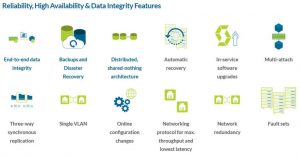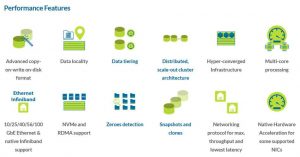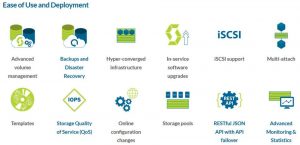StorPool V.18.02 With “30% Lower Latency”, Kubernetes Integration and Support for Hyperscale Datacenter Networks
Capabilities providing everything needed to ensure efficient, reliable and scalable storage solution for any business.
This is a Press Release edited by StorageNewsletter.com on November 14, 2018 at 2:35 pmStorPool Storage announced its release V.18.02.
Click to enlarge
This version incorporates capabilities providing everything needed to ensure efficient, reliable and scalable storage solution for any business.
The company’s Block Storage is recognized by cloud and hosting providers as a fast and reliable solution in the domain, thanks to its low latency and data redundancy. With this release, the firm puts an emphasis on new integrations, extended hardware compatibility, hardware acceleration, and reduced resource usage.
Click to enlarge
What you will find in release:
-
Kubernetes integration
-
-
The company provides reliable persistent block-storage for Kubernetes. Kubernetes is an open-source project that came out of Google – a container orchestrator which has a built-in support for running and managing containers, monitoring, load balancing, and auto-scaling.
-
Kubernetes is a way to run cloud-native applications in large clusters by abstracting away the underlying nodes and other infrastructure. It provides resource scheduling, horizontal scaling, lifecycle management and more.
-
The integration enables Kubernetes to create and use the storage volumes provided by a StorPool storage cluster and to migrate the workloads between container nodes.
-
-
Click to enlarge
-
Enhanced hardware platform compatibility with release
It has extended its hardware support. This enables its customers to build more sophisticated infrastructure and storage systems on the latest generation of hardware. Some of the newly supported hardware components are:-
-
4Kn drives – more information about them can be found here
-
Hotplug NVMe – making it to manage the infrastructure without rebooting servers
-
ARM and POWER8/9 architectures
-
Traditionally, ARM was associated with mobile phones because of its low power consumption and its efficiency. More recently, the IT infrastructure industry recognizes ARM server processors as a viable challenger to the x86 server architecture. It may become common in public cloud, hyperscale, telco, and edge computing.
-
The POWER processor architecture was originally developed by IBM. The typical use case for POWER is enterprise workloads and the customers are banks, telcos, and companies with a demand for servers to build complex infrastructure. The POWER architecture has gained new interest because POWER CPUs are being integrated into third-party servers through the OpenPOWER initiative.
-
-
-
30% lower storage latency
For the majority of use-cases, latency is the most important metric of a storage system. It is more important than IO/s. Since many applications are performing inter-dependent storage operations – the lower the latency of a storage system the faster the application is.-
-
This version has typically 30% lower storage operations latency than the previous version. This is achieved via accelerated mode (also known in the industry as kernel bypass). The accelerated mode is supported for Intel, Mellanox, and Broadcom NICs.
-
With accelerated mode and NVMe drives, a StorPool storage system, with triple redundancy across nodes, end-to-end data integrity, and advanced data management features commits 4K write operations in approximately 50μs.
-
-
-
Linux distributions supported
The release is coming with support for new distributions. The company already supports Ubuntu 18.04 LTS. As usual, the company is keeping up with updates to all supported distributions to make sure the company offers the best storage solution for customers.
-
Support for hyperscale datacenter networks
Unlike smaller public and private clouds, hyperscale deployments typically use a routed leaf/spine datacenter networks.-
-
In this release, the firm supports routed leaf/spine datacenter networks, to enable deployments in hyperscale infrastructure. This is in addition to the simpler flat Ethernet topology, which is used in small to mid-sized deployments because it is simpler.
-
-
-
Enhanced analytics and metrics collection
Having full insight into the storage and the infrastructure allows any company to make a detailed analysis, make data-driven decisions and utilize it better to increase efficiency and cut costs. The firm’s release 18.02 includes better analytics with detailed per-node CPU and memory statistics. The CPU analytics feature enables the company’s customers to monitor CPU load and congestion on hypervisor nodes. While CPU on hypervisors is not strictly a storage system metric, it is a common cause for complaints about ‘slow storage’, hence StorPool extended metrics collection to cover it too.
Click to enlarge
Additional improvements:
-
Reliability and performance improvements of the multi-site connectivity
-
Lower CPU usage and higher efficiency for storpool_block during TRIM operations
-
Tool added – transfer_status to show the status of the currently running bridge transfers
-
Tool added – sDump to print network stats in a human-readable format
-
StorPool CLI prompt available to be customized using the SP_CLI_PROMPT variable
-
Improved fio test scripts
-
Tool storpool_ping, for measuring latency and throughput across the storage network, and a higher level tool for quickly checking network connectivity and performance between all storage server and initiator nodes
Boyan Krosnov, CPO, StorPool, said: “StorPool relied on our experience with hundreds of public and private clouds. We added optimal use of hyperscale leaf-spine networks, an integration into the leading container orchestration platform Kubernetes, and many small improvements. StorPool’s performance was exceptional, but we like to push the boundaries of what’s possible. That’s why we implemented what we call ‘accelerated mode’ for NICs. We can now complete storage operations in microseconds of latency without sacrificing any of the advanced features. It is not about the ‘hero IO/s numbers’. Consistently low storage latency takes real-world application performance to unprecedented highs.“


















 Subscribe to our free daily newsletter
Subscribe to our free daily newsletter

